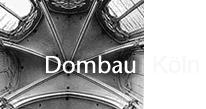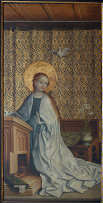Prie-dieu
The Virgin’s prie-dieu underwent a particularly complex sequence of changes, starting with the underdrawing, and continuing through the first lay-ins in paint all the way to the finished version. In the underdrawing the top of prie-dieu, including the book, was higher and broader (see red mapping lines). In addition, the front, cropped by the edge of the picture, was almost completely covered by a hanging cloth. To judge by the fall of the folds and the wide fringed border, this may have been a continuation of the curtain depicted in the background, which would thus have framed the depiction on the left-hand edge of the picture. In the painting, however, the curtain was never realized in this position, probably not least because placing it there in front of the prie-dieu would have led to a flattening of the perspective. Also ignored in the painting process, although present in the drawing, was the shape of a rosette which filled the side of the prie-dieu. Instead of this, a different tracery form, consisting of a rose, trefoils and lancets was next planned for the front and side (see pale blue mapping lines). But while the painting process was under way, yet another decision was taken, and the final version of the blind tracery, intersecting ogee arches, was executed. All three decorative forms represent variations of traceries of the Parler period, and extend back, stylistically, to the fourteenth century. The first two tracery shapes, based on roses, do however display egregious construction errors (e.g. in the lancet rosette with its odd number of points, in the radial relationship, and in the symmetry). It seems likely that the draughtsman was not well versed in Gothic architectural geometry, and doubtless eventually rejected the two rose elements as failures. The interpenetrating ogee figure as finally chosen was easier to construct, and there were plenty of examples of it in the Cologne region.
In parallel with the changes in the form and ornamentation of the prie-dieu, changes were also made to the design of the adjacent parts of the Virgin’s cloak. These include changes to the fall of the garment, in the area both of the knees and the shoulders. Thus the bottom part of the cloak in the underdrawing flowed around the edge of the prie-dieu, and rested on the base, while in the painting it runs behind the prie-dieu, enhancing the perspective effect through the echelon thus created.
(We owe the interpretation of the tracery forms in the context of Gothic architectural geometry to Prof. Norbert Nussbaum, Cologne)
projekt von:













